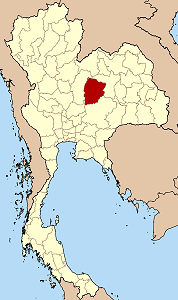Chaiyaphum Province
|
|
| Statistics | |
|---|---|
| Capital: | Chaiyaphum |
| Area: | 12,778.3 km² Ranked 7th |
| Inhabitants: | 1,095,360 (2000) Ranked 14th |
| Pop. density: | 86 inh./km² Ranked 50th |
| ISO 3166-2: | TH-36 |
| Map | |

| |
Chaiyaphum (Thai ชัยภูมิ) is one of the north-eastern provinces (changwat) of Thailand. Neighboring provinces are (from north clockwise) Khon Kaen, Nakhon Ratchasima, Lopburi and Phetchabun.
| Contents |
Geography
The province is cut into two halves by the Phetchabun mountain range, with the highest elevation in the province at 1222 m. The east of the province belongs to the Khorat Plateau.
Three national parks are located in the province. The Tat Tohn National Park is in north-west of the province, featuring some scenic waterfalls and dry dipterocarp forests. The biggest attraction of the Sai Thong National Park in the west of the province is the Sai Thong waterfall, but also some fields of the Siam Tulip. Similar fields can be found in the Pa Hin Ngam National Park in the south-west, scheduled to be gazetted in the future. This park has its name from the strangely shaped rock formations found there (beautiful rock forest).
History
The history of the city of Chaiyaphum dates back to the Khmer Empire in the 12th century, when it was a small city on the route from Angkor to Prasat Singh (Kanchanaburi province). The Prang Ku still remains from this time. In 1817 the area was settled again by a group of Laotians. At first they settled in Baan Nam Khun Nong E Chan (Nakhon Ratchasima province), but soon moved to the current site of Chaiyaphum, then called Baan Luang. When the Lao King Anouvong declared war on Siam, the local ruler Jao Phraya Lae changed allegiance and supported the Siamese troops. In 1826 he was killed by Laotian troops, before these were defeated and all of Laos became part of Siam. Jao Phraya Lae was renamed by the Thais to Phraya Phakdi Chumpon and is still a local hero.
People
Most people in Chaiyaphum province are ethnically Lao. The Isaan (or Northeast) dialect of Thai (similar to Laotian) is the first language for most people in Chaiyaphum.
Culture
Chaiyaphum is a center for the Northeastern Thai musical styles Mor lam and Mor lam sing.
Agriculture and Industry
Principal crops in Chaiyaphum include rice, tapioca, sugar cane and taro root. Chaiyaphum is renowned as a center for the Thai silk industry.
Symbols
| Missing image Seal_Chaiyaphum.png Provincial seal | The provincial seal shows a triangular flag, a symbol of victory in war.
The provincial tree is Siamese senna (Cassia siamea), and the provincial flower the Siam Tulip (Curcuma alismatifolia). The provincial slogan เมืองโบราณ บ้านนักสู้ ภูเสียดฟ้า ป่าช้างหลาย ทุ่งไพรรก น้ำตกใส ผ้าไหมดี สตรีงาม แดนธรรมแดนทอง translates to Enchanted city, home to heroes, mountain peaks, elephant forests, waterfalls, beautiful silk, lovely ladies, conscientious Buddhists.. |
Administrative divisions
Amphoe_Chaiyaphum.png
Map of Amphoe
The province is subdivided into 15 districts (Amphoe) and one minor districts (King Amphoe). The districts are further subdivided into 124 communes (tambon) and 1393 villages.
| Amphoe | King Amphoe | |
|---|---|---|
|
|
|
External links
- Province page from the Tourist Authority of Thailand (http://www.tourismthailand.org/province/province.php?id=34)
- Golden Jubilee Network province guide (http://kanchanapisek.or.th/cgi-bin/kp8/oncc/province.cgi?prov=e3)
fr:Province de Chaiyaphum ja:チャイヤプーム県 ms:Wilayah Chaiyaphum nl:Changwat Chaiyaphum th:จังหวัดชัยภูมิ

